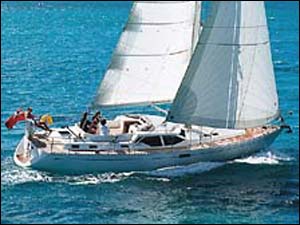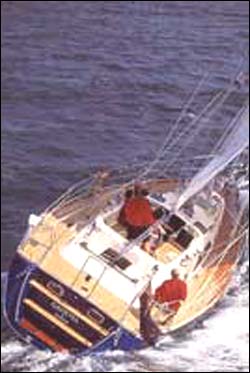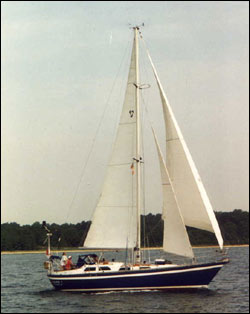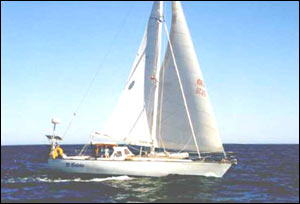|
Walking back to the
boat from Tobacco Bay, a warm, shallow, near perfect swimming hole
tucked below Fort St. Catherine's on the northeast tip of Bermuda, I
paused to catch my breath at the top of the hill. Breathing heavier
than I should have been, I was relieved to be over the hump-now it
was all down hill into St. George's.With the wind at my back, I
detoured east knowing that in a few minutes I'd come to a narrow
lane that offered a sweeping view of the harbor. I carefully slipped
past a thorny bougainvillea hedge, found a perch on smooth rock,
twisted the cap on a beer that I'd been schlepping just for the
occasion, and toasted the picturesque scene below.
Although mid June was a little late in the season, the harbor was
still jam packed with cruising boats. Many had just arrived
from the Caribbean, others had sailed south from New England. Most
were taking a break before heading across the Atlantic to
Europe. These boats were real blue-water cruisers: they were
decked out with solar panels, steering vanes, dodgers, and full
cockpit enclosures. A rust streak or two streamed down the
topsides and drying clothes and bedding flapped from the lifelines
and rigging. However, as I stared down at the aquamarine water (St.
George's inner harbor is still one of my all time favorite
anchorages), it struck me, "they're all 45-foot center cockpit
cutters."
Of
course there were some aft cockpit sloops (including my own Kaufman
47) and a handful of ketches and even a few traditional boats were
scattered about, but a disproportionate number were center cockpit
cruisers with two furling headsails. Even from that distance
and my eyes not being what they once were, I could easily identify a
Hylas 46, a Brewer 44, a CSY 44, a Roberts 45, a Peterson 44, a
Norseman 447, an Oyster 45, and even a lovely old Bowman
46. Was my observation just an anomaly or did these boats
represent an accurate profile of today's cruising
boats? Have 45-foot center cockpit cutters staged a coup
and taken over cruising? While I can't say this burning
question kept me up that night, it did spark an interest to find out
just what type of cruising boats are really "out there."
"Were have you
been," asked Ft. Lauderdale broker Rob Jordan, when I recently asked
him about the great center cockpit conspiracy, "I thought you were
supposed to be some kind of expert?" Rob, whose firm specializes in
blue-water cruising boats, layed out the parameters for most of his
clients "It's simple really, they want a 45 to 50-foot center
cockpit design with a moderate keel and draft, a cutter rig and a
big aft cabin with a centerline queen. I know what they want, the
problem is finding the boats." Hmm, it seemed like I was onto
something, although apparently the brokers had been on to it long
before me. Although the majority of today's new
production cruising boats are still aft cockpit models, it seems
hardcore cruisers are looking for something else.
Let's not jump to conclusions, I told myself-journalistic
integrity demanded that I conduct some scientific research into this
critical matter. OK, I confess, scientific might be a reach-my
statistical base would make the number crunching honchos that run
the CNN/USA TODAY polls cringe. But hey, we're talking sailboats,
not politics, although I'm not sure which is really more important.
Anyway, with all due respect to George Gallup, I recently conducted
the Kretschmer Survey on cruising boats and hereby make my findings
available to sailors of all political parties.
To get started, I
compiled a list of all the "cruising boats" that I have delivered
over the past 10 years. I classified cruising boats as
those personally owned (not charter boats) and those that were
either being purchased for an upcoming sabbatical or being delivered
to Ft. Lauderdale to be sold after the big cruise was concluded or
aborted.
This list totaled 44 boats, ranging from 71 to
33 feet. When I added up the LOAs and divided by 44, amazingly
the average came out to be 44.6 feet-as
Dave Berry would say, I swear I am not making this up.Twenty-six of
the boats, or 59 percent were center cockpits but only 15, or
34 percent were cutters. Realizing that this data is
slightly dated, I next took a look at the boats that contributed to
the last two years of SSCA bulletins-these
are the boats that really out there cruising.
The SSCA, or Seven Seas Cruising Association is a group of close
to 10,000 sailors dedicated to voyaging. Liveaboard sailors
contribute updates to worldwide cruising destinations in their
monthly publication, which, by the way, is the most current cruising
information available anywhere. A typical bulletin may contain
dispatches from Madagascar, French Polynesia, and the Florida Keys.
Each contributor lists his or her boat type and draft. From the type
of boat I deduced if it was a center cockpit and its likely rig.
Eighty-five boats contributed to the bulletins in 2002 and 2003
(through August), ranging from a Cal 25 to an 84-foot Palmer Johnson
ketch. The average LOA turned out to be 43.5 feet, 55
percent were center cockpits, 50 percent were cutters and
just for fun, 96 percent were fiberglass, and 95
percent were monohulls. When you add the two sample
pools together, the resulting average cruising boat is 44
feet and there's a better than 50 percent chance that it
has a center cockpit deck arrangement.
 |
| "Forty-five feet is an ideal length when it
comes to combining comfort, seakindliness, and
performance." |
 | So, there you have it, the votes
are in but what does it all mean? I not sure. We need TV pundits to
banter back and forth and explain it to us. I think it's safe to say
that yes indeed, there are a lot of 40 to 50-foot center cockpit
cutters "out there." Not a stirring conclusion, but one that makes
sense. Dramatically improved sail handling systems allow
small crews, i.e. couples, to sail larger boats
efficiently. Forty-five feet is an ideal length when
it comes to combining comfort, seakindliness, and performance. And
whether you love them or loathe them from an aesthetic perspective,
it is hard to dispute that center cockpit boats offer friendlier
interior arrangements for liveaboard cruisers.
Just to sample what's available in the center cockpit world
cruisers, let's now take a brief look at two older but still highly
sought after second-hand center cockpit boats. The Tayana 42 and the
Peterson 44 are not only good solid boats, but they're also sound
values in today's market. Incidentally, these boats and many others
are described in much more detail in my book, Used Boat
Notebook, which, not surprisingly, is available right here
at Sailnet.
|
And The Winners Are...
Here's a quick overview of what are perhaps the two most
popular oldies when it comes to center cockpit world
cruisers.
Tayana
42 Designed by Robert Harris
and built by Ta Yang in Taiwan, this boat is ostensibly still
in production, although a new boat hasn't been built in years
and most of the 42s on the market date from the early
'80s. The Tayana 42, also known as the Vancouver
42, came with three different deck plans, two of which were
aft cockpits. The center cockpit model accounted for
about a quarter of the 200-plus boats built and ironically it
is the one most sought after by world cruisers. The hull
shape features a deep forefoot, a large fin keel, and full
skeg hung rudder. he distinctive feature is the canoe stern,
which definitely looks better on the aft cockpit models. The
42 is no lightweight; when loaded for cruising, the
displacement is well over 30,000 lbs.
A key reason for the 42s enduring popularity is that it is
a robustly constructed boat with a solid fiberglass hull and
cored deck. Early boats had plywood cores, later balsa was
used. Teak decks, with all their virtues and vices, are
common. Bulkheads are tabbed directly to the hull, linings and
moldings are not used, this boat does not creak in a seaway.
The cast iron ballast is internal. Almost all the
boats were rigged as cutters and the mast is deck
stepped.
The interior plan varies from boat to boat because Ta Yang
encouraged owner participation in the design. Most boats have
a V berth or offset double forward followed by the head and
main saloon. The large galley is to port and the walkthrough
to the aft cabin is to starboard. The aft cabin features a
second head and a large double, usually arranged athwartships.
The teak joinery throughout is excellent. Items to watch
for include corroded tanks and chainplates, deck leaks, and
delamination. A quick Internet search produced seven
Tayana 42 center cockpits for sale, with prices ranging from
just over $100,000 to $140,000.
Peterson 44
The center cockpit Peterson 44 is a favorite among world
cruisers because it genuinely blends comfort and performance.
Conceived by San Diego yacht broker Jack Kelly and designed by
Doug Peterson, approximately 200 44s were built in Taiwan
during a six-year production run. The Kelly Peterson 46
replaced the 44 and if you're interested in the 44 you should
also give these boats a close inspection. The Peterson 44 hull
shape is similar to the Tayana 42, but a bit more refined. The
flat stern, longer LOA, lower freeboard, finer forefoot, and
taller rig combine to make the boat a much better performer.
It is also a very nice looking boat-even confirmed aft cockpit
sailors concede the point.
Like most
Taiwan boats of this era (1976-1983), the hull is heavily laid
up, solid fiberglass-in fact it's more than an inch thick at
the turn of the bilge. The decks and trunkhouse are cored with
plywood, which is not a great material for the task, yet
surprisingly delamination does not seem to be a huge problem.
Like the Tayana 42, the ballast is cast iron encapsulated in
the keel cavity.
The interior plan usually features a
V berth forward with a large head just aft. The main saloon
includes a dinette to port. The galley is also to port and low
walkthrough is to starboard, although the aft cabin is also
accessible from the cockpit, a great feature that is rarely
available in modern boats. Items to watch for include trouble
with teak decks and suspect tanks, they're made of black iron
and water tanks especially were prone to rusting. SailNet
readers are familiar with Sue and Larry's terrific accounts of
upgrading their Kelly Peterson 46, including how they removed
their deck decks and replaced them with Treadmaster. Original
44s had rigging problems, especially the Navtec turnbuckles,
but most boats on the market will have been rerigged by now.
Nine 44s, ranging from $110,000 to $150,000 turned up for sale
on line.
| |




